
Worldwide, Gender Divide Remains in Full-Time Employment
Story Highlights
- Biggest gender gaps for P2P in MENA, South Asia
- Smallest gender gaps in Northern Europe, Sub-Saharan Africa
- Women report higher unemployment worldwide
WASHINGTON, D.C. -- The percentage of women working full time for an employer in 2014 did not reach 50% in any country, while this percentage was 50% or higher for men in 13 countries. Women tended to have the highest Payroll to Population (P2P) employment rates in countries with stronger social safety nets and labor market regulations, while the countries with the highest P2P rates for men were a mix of these and more liberal economies.
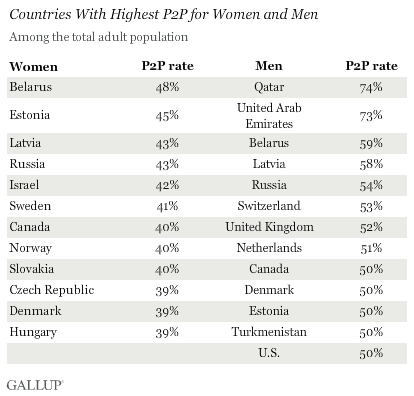
This disproportion is evident at the global level. Worldwide, the P2P rate for women was 19%, compared with 33% for men. Although the 14-percentage-point gap between men and women in 2014 was the narrowest measured since 2009 by one point, percentages have generally stayed within the same range for the past six years.
Gallup's latest global P2P measurements are based on more than 182,000 interviews across 144 countries in 2014, in which adults were asked a battery of employment questions modeled from International Labour Organization (ILO) standards. Gallup does not count adults who are self-employed, working part time, unemployed or out of the workforce as payroll-employed in the P2P metric, and it is not seasonally adjusted.
In every region of the world, women in 2014 continued to trail men in the percentage who are working full time for an employer. Women's deficit in the good jobs market remained largest in South Asia and in the Middle East and North Africa (MENA), where their P2P rates lagged behind men's rates by at least 20 points.
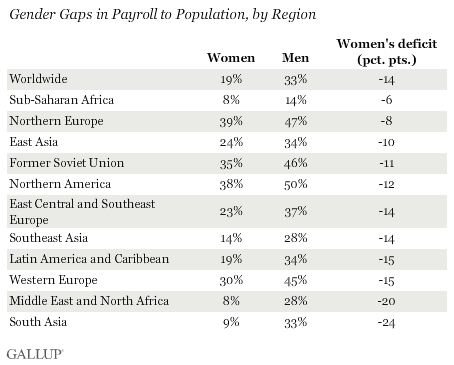
Overall, in 130 out of the 144 countries surveyed, women's P2P rates lagged significantly behind men's. The 14 countries with the smallest gender gaps in P2P were mostly in sub-Saharan Africa, where P2P was low for both men and women. Conversely, more developed countries such as Cyprus, Israel and Slovakia -- which have relatively high P2P rates for both genders -- also ranked in the top 10 for gender parity.
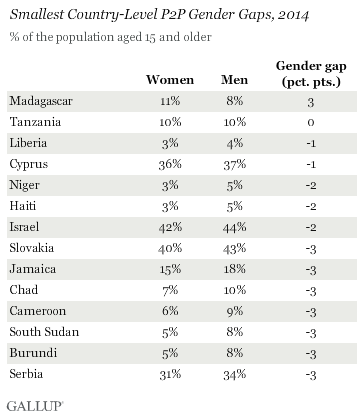
Several countries in the Middle East and North Africa and South Asia were at the bottom of the gender-parity list, along with some European additions: the Netherlands and Switzerland. However, whereas lower P2P among women in the countries in MENA or South Asia was primarily driven by lower workforce participation, in the Netherlands and Switzerland this was attributable instead to much higher rates of part-time employment for women in these countries.
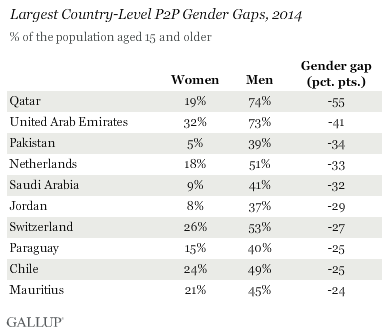
Women Less Likely to Participate in the Workforce
The Middle East and North Africa had the lowest workforce participation of any region in 2014, with 51% of the adult population neither working nor looking for and available to work. This rate is driven in part by the low rate of participation among women. The Middle East and North Africa and South Asia regions had the largest employment gaps by gender in 2014, with one-third or less of adult women participating in the workforce in each region.
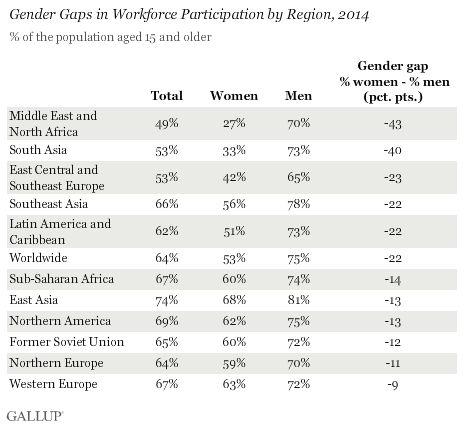
Workforce participation measures the percentage of adults who are working or who are unemployed. Gallup defines unemployment as those adults who did not have any paid work in the past seven days, for an employer or themselves, and who were actively looking for and available to work. Adults who were not employed and were not looking for and available to work -- including full-time students, homemakers, the retired or the disabled -- were classified as out of the workforce.
Women in the Workforce Report Slightly Higher Unemployment
Women worldwide were much less likely to be participating in the workforce -- 53% worldwide did so in 2014, compared with 75% of men -- but women who did participate were also more likely to be unemployed than their male counterparts.
Unlike Gallup's P2P rate, which is a percentage of the total population, the unemployment rate that Gallup reports is a percentage of the workforce. The global unemployment rate among women in the workforce in 2014 was 10%, compared with 6% among men in the workforce. Saudi Arabia had the highest unemployment rate among women in the workforce at 52%, while Thailand and Taiwan had the lowest at 1%.
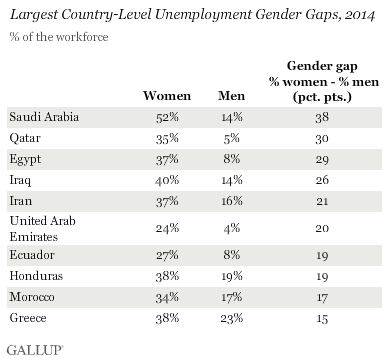
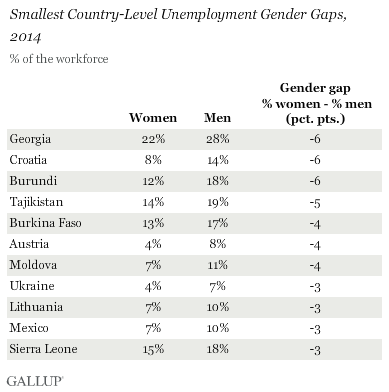
Implications
Cultural restrictions and influences continue to limit women's participation in economic life worldwide and especially their full-time employment. Yet culture and economics occasionally interact in unexpected ways -- the examples of Switzerland and the Netherlands show that sometimes the option to not work a full-time job represents greater freedom in terms of economic choices. However, where women's unemployment rates continue to outpace men's -- even while their overall workforce participation simultaneously lags -- more work needs to be done to engage this essential half of the world's human capital.
The data in this article were generated from Gallup Analytics .
Read the full Good Jobs 2014 report.
Survey Methods
Results are based on telephone and face-to-face interviews with approximately 1,000 adults in each country, aged 15 and older, conducted in 2014. For results based on the total sample of national adults, the margin of sampling error ranged from ±2.1 percentage points to ±5.6 percentage points at the 95% confidence level. The margin of error reflects the influence of data weighting. In addition to sampling error, question wording and practical difficulties in conducting surveys can introduce error or bias into the findings of public opinion polls.
For more complete methodology and specific survey dates, please review Gallup's Country Data Set details.
Learn more about how the Gallup World Poll works.
